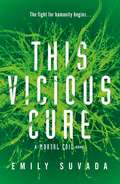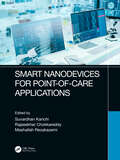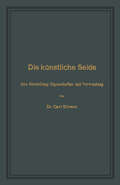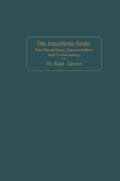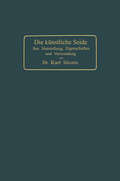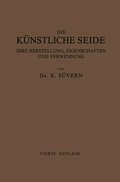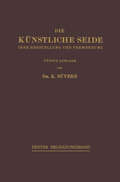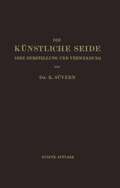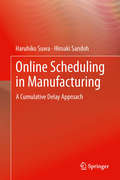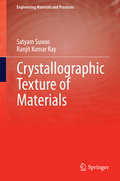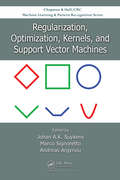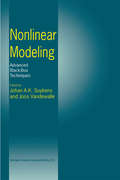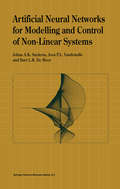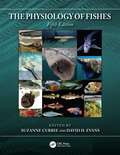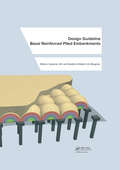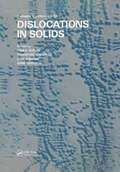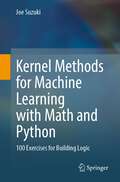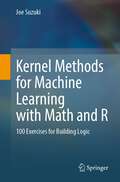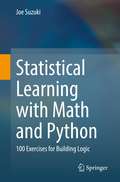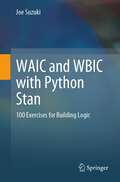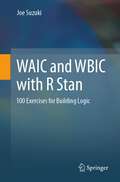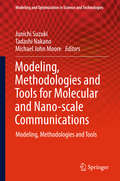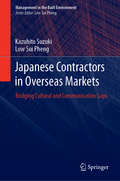- Table View
- List View
This Vicious Cure (This Mortal Coil #3)
by Emily Suvada*The extraordinary conclusion to the This Mortal Coil trilogy - who will survive the oncoming storm?*Two factions at warA plague that can't be stoppedA cure that could destroy them all . . .Cat's hacking skills weren't enough to keep her from losing everything - her identity, her past, and now her freedom. Meanwhile, the person who's stolen everything from her is close to realizing a hacker's dream: the solution to humanity's problems in gene form. Or so she thinks . . .But now a new threat has emerged - a threat that could bring the world to the brink of a devastating war.Both sides will stop at nothing to seize control of humanity's future, and that the centre of this war is Cat, and a race against the clock save millions of lives . . .The gripping finale to a series The Verge has called 'perfect YA sci-fi'
Smart Nanodevices for Point-of-Care Applications
by Suvardhan Kanchi, Rajasekhar Chokkareddy and Mashallah RezakazemiSmart Nanodevices for Point-of-Care Applications examines the latest trends on the capabilities of nanomaterials for point-of-care (PoC) diagnostics and explains how these materials can help to strengthen, miniaturize, and improve the quality of diagnostic devices. A thorough explanation of all-in-one nanosmart devices is included, incorporating all of the applications and fundamentals of these smart devices. This book provides practical information on the following: novel and effective smart materials, better-quality health management, effective management of a disease, potential point-of-care devices, and mobile nanosensors. Additional Features Includes in-depth research based collation of the latest trends of smart devices Provides practical information on all-in-one nanosmart devices Explains how nanomaterials can help to strengthen and improve the quality of diagnostic devices Emphasizes the development of smart nanodevices, especially the miniaturization aspect
Die künstliche Seide: Ihre Herstellung, Eigenschaften und Verwendung
by Karl SüvernDieser Buchtitel ist Teil des Digitalisierungsprojekts Springer Book Archives mit Publikationen, die seit den Anfängen des Verlags von 1842 erschienen sind. Der Verlag stellt mit diesem Archiv Quellen für die historische wie auch die disziplingeschichtliche Forschung zur Verfügung, die jeweils im historischen Kontext betrachtet werden müssen. Dieser Titel erschien in der Zeit vor 1945 und wird daher in seiner zeittypischen politisch-ideologischen Ausrichtung vom Verlag nicht beworben.
Die Künstliche Seide ihre Herstellung, Eigenschaften und Verwendung: Mit Besonderer Berücksichtigung der Patent-Litertur
by Karl SüvernDieser Buchtitel ist Teil des Digitalisierungsprojekts Springer Book Archives mit Publikationen, die seit den Anfängen des Verlags von 1842 erschienen sind. Der Verlag stellt mit diesem Archiv Quellen für die historische wie auch die disziplingeschichtliche Forschung zur Verfügung, die jeweils im historischen Kontext betrachtet werden müssen. Dieser Titel erschien in der Zeit vor 1945 und wird daher in seiner zeittypischen politisch-ideologischen Ausrichtung vom Verlag nicht beworben.
Die Künstliche Seide: Ihre Herstellung und Verwendung
by Karl Süvern H. FrederkingDieser Buchtitel ist Teil des Digitalisierungsprojekts Springer Book Archives mit Publikationen, die seit den Anfängen des Verlags von 1842 erschienen sind. Der Verlag stellt mit diesem Archiv Quellen für die historische wie auch die disziplingeschichtliche Forschung zur Verfügung, die jeweils im historischen Kontext betrachtet werden müssen. Dieser Titel erschien in der Zeit vor 1945 und wird daher in seiner zeittypischen politisch-ideologischen Ausrichtung vom Verlag nicht beworben.
Die Künstliche Seide: Ihre Herstellung und Verwendung
by Karl Süvern H. FrederkingDieser Buchtitel ist Teil des Digitalisierungsprojekts Springer Book Archives mit Publikationen, die seit den Anfängen des Verlags von 1842 erschienen sind. Der Verlag stellt mit diesem Archiv Quellen für die historische wie auch die disziplingeschichtliche Forschung zur Verfügung, die jeweils im historischen Kontext betrachtet werden müssen. Dieser Titel erschien in der Zeit vor 1945 und wird daher in seiner zeittypischen politisch-ideologischen Ausrichtung vom Verlag nicht beworben.
Online Scheduling in Manufacturing: A Cumulative Delay Approach
by Haruhiko Suwa Hiroaki SandohOnline scheduling is recognized as the crucial decision-making process of production control at a phase of “being in production" according to the released shop floor schedule. Online scheduling can be also considered as one of key enablers to realize prompt capable-to-promise as well as available-to-promise to customers along with reducing production lead times under recent globalized competitive markets.Online Scheduling in Manufacturing introduces new approaches to online scheduling based on a concept of cumulative delay. The cumulative delay is regarded as consolidated information of uncertainties under a dynamic environment in manufacturing and can be collected constantly without much effort at any points in time during a schedule execution. In this approach, the cumulative delay of the schedule has the important role of a criterion for making a decision whether or not a schedule revision is carried out. The cumulative delay approach to trigger schedule revisions has the following capabilities for the practical decision-making:1. To reduce frequent schedule revisions which do not necessarily improve a current situation with much expense for its operation;2. To avoid overreacting to disturbances dependent on strongly an individual shop floor circumstance; and3. To simplify the monitoring process of a schedule status.Online Scheduling in Manufacturing will be of interest to both practitioners and researchers who work in planning and scheduling in manufacturing. Readers will find the importance of when-to-revise policies during a schedule execution and their influences on scheduling results.
Crystallographic Texture of Materials (Engineering Materials and Processes)
by Satyam Suwas Ranjit Kumar RayProviding a comprehensive and invaluable overview of the basics of crystallographic textures and their industrial applications, this book covers a broad range of both structural and functional materials. It introduces the existing methods of representation in an accessible manner and presents a thorough overview of existing knowledge on texture of metallic materials. Texture analysis has widespread use in many industries, and provides crucial input towards the development of new materials and products. There has been rapid growth in the science and art of texture analysis in the last few decades. Other topics addressed within this book include recent research on texture in thin films and non-metals, and the dependence of material properties on texture, and texture control in some engineering materials.This book constitutes an invaluable reference text for researchers and professionals working on texture analysis in metallurgy, materials science and engineering, physics and geology. By using content selectively, it is also highly accessible to undergraduate students.
Regularization, Optimization, Kernels, and Support Vector Machines
by Johan A. K. Suykens Marco Signoretto Andreas ArgyriouRegularization, Optimization, Kernels, and Support Vector Machines offers a snapshot of the current state of the art of large-scale machine learning, providing a single multidisciplinary source for the latest research and advances in regularization, sparsity, compressed sensing, convex and large-scale optimization, kernel methods, and support vecto
Nonlinear Modeling: Advanced Black-Box Techniques
by Johan A. K. Suykens Joos P. L. VandewalleNonlinear Modeling: Advanced Black-Box Techniques discusses methods on Neural nets and related model structures for nonlinear system identification; Enhanced multi-stream Kalman filter training for recurrent networks; The support vector method of function estimation; Parametric density estimation for the classification of acoustic feature vectors in speech recognition; Wavelet-based modeling of nonlinear systems; Nonlinear identification based on fuzzy models; Statistical learning in control and matrix theory; Nonlinear time-series analysis. It also contains the results of the K.U. Leuven time series prediction competition, held within the framework of an international workshop at the K.U. Leuven, Belgium in July 1998.
Artificial Neural Networks for Modelling and Control of Non-Linear Systems
by Johan A.K. Suykens Joos P.L. Vandewalle B.L. de MoorArtificial neural networks possess several properties that make them particularly attractive for applications to modelling and control of complex non-linear systems. Among these properties are their universal approximation ability, their parallel network structure and the availability of on- and off-line learning methods for the interconnection weights. However, dynamic models that contain neural network architectures might be highly non-linear and difficult to analyse as a result. Artificial Neural Networks for Modelling and Control of Non-Linear Systems investigates the subject from a system theoretical point of view. However the mathematical theory that is required from the reader is limited to matrix calculus, basic analysis, differential equations and basic linear system theory. No preliminary knowledge of neural networks is explicitly required. The book presents both classical and novel network architectures and learning algorithms for modelling and control. Topics include non-linear system identification, neural optimal control, top-down model based neural control design and stability analysis of neural control systems. A major contribution of this book is to introduce NLq Theory as an extension towards modern control theory, in order to analyze and synthesize non-linear systems that contain linear together with static non-linear operators that satisfy a sector condition: neural state space control systems are an example. Moreover, it turns out that NLq Theory is unifying with respect to many problems arising in neural networks, systems and control. Examples show that complex non-linear systems can be modelled and controlled within NLq theory, including mastering chaos. The didactic flavor of this book makes it suitable for use as a text for a course on Neural Networks. In addition, researchers and designers will find many important new techniques, in particular NLq Theory, that have applications in control theory, system theory, circuit theory and Time Series Analysis.
The Physiology of Fishes (CRC Marine Biology Series)
by Suzanne Currie and David H. EvansThe fifth edition of The Physiology of Fishes represents a compendium of knowledge across fish physiology, collecting up-to-date research into an easy-to-access single textbook. Written by the leaders in the field, it provides a comprehensive, accessible review of the core topics, integrating physiology with environmental science, ecology, evolution, and molecular cell biology. New chapters address Epigenetics, Biomechanics and Locomotion, and Behaviour and Learning. Each chapter contains an extensive bibliography, providing readers with the best sources from the primary literature. Almost three decades after the publication of the first edition, this book remains the only published single-volume work on fish physiology. The fifth edition provides an important reference for new students of fish biology, marine and freshwater biologists, ichthyologists, fisheries scientists, and comparative physiologists.
Design Guideline Basal Reinforced Piled Embankments
by Suzanne J.M. Eekelen Marijn H.A. BrugmanA basal reinforced piled embankment consists of a reinforced embankment on a pile foundation. The reinforcement consists of one or more horizontal layers of geosynthetic reinforcement installed at the base of the embankment.A basal reinforced piled embankment can be used for the construction of a road or a railway when a traditional construction method would require too much construction time, affect vulnerable objects nearby or give too much residual settlement, making frequent maintenance necessary.This publication is a guideline (CUR226) for the design of basal reinforced piled embankments. The guideline covers the following subjects: a survey of the requirements and the basic principles for the structure as a whole; some instructions for the pile foundation and the pile caps; design rules for the embankment with the basal geosynthetic reinforcement; extensive calculation examples; finite element calculations; construction details and management and maintenance of the piled embankment. The guideline includes many practical tips. The design guideline is based on state-of-the-art Dutch research, which was conducted in cooperation with many researchers from different countries.
Design Guideline Basal Reinforced Piled Embankments
by Suzanne J.M. van Eekelen; Marijn H.A. BrugmanA basal reinforced piled embankment consists of a reinforced embankment on a pile foundation. The reinforcement consists of one or more horizontal layers of geosynthetic reinforcement installed at the base of the embankment.A basal reinforced piled embankment can be used for the construction of a road or a railway when a traditional construction method would require too much construction time, affect vulnerable objects nearby or give too much residual settlement, making frequent maintenance necessary.This publication is a guideline (CUR226) for the design of basal reinforced piled embankments. The guideline covers the following subjects: a survey of the requirements and the basic principles for the structure as a whole; some instructions for the pile foundation and the pile caps; design rules for the embankment with the basal geosynthetic reinforcement; extensive calculation examples; finite element calculations; construction details and management and maintenance of the piled embankment. The guideline includes many practical tips. The design guideline is based on state-of-the-art Dutch research, which was conducted in cooperation with many researchers from different countries.
Dislocations in Solids
by Hideji Suzuki Toshiyuki Ninomiya Koji Sumino Shin TakeuchiThis volume comprises the Proceedings of the Yamada Conference IX on Dislocations in Solids, held in August 1984 in Tokyo. The purpose of the conference was two-fold: firstly to evaluate the increasing data on basic properties of dislocations and their interaction with other types of defects in solids and, secondly, to increase understanding of the material properties brought about by dislocation-related phenomena. Metals and alloys, semi-conductors and ions crystals were discussed. One of the important points of contention was the electronic state at the core of dislocation. Another was the dislocation model of amorphous structure.
Dislocations in Solids
by Hiroshi Suzuki Koji Sumino Shin Takeuchi Toshiyuki NinomiyaThis volume comprises the Proceedings of the Yamada Conference IX on Dislocations in Solids, held in August 1984 in Tokyo. The purpose of the conference was two-fold: firstly to evaluate the increasing data on basic properties of dislocations and their interaction with other types of defects in solids and, secondly, to increase understanding of the material properties brought about by dislocation-related phenomena. Metals and alloys, semi-conductors and ions crystals were discussed. One of the important points of contention was the electronic state at the core of dislocation. Another was the dislocation model of amorphous structure.
Kernel Methods for Machine Learning with Math and Python: 100 Exercises for Building Logic
by Joe SuzukiThe most crucial ability for machine learning and data science is mathematical logic for grasping their essence rather than relying on knowledge or experience. This textbook addresses the fundamentals of kernel methods for machine learning by considering relevant math problems and building Python programs. The book’s main features are as follows:The content is written in an easy-to-follow and self-contained style.The book includes 100 exercises, which have been carefully selected and refined. As their solutions are provided in the main text, readers can solve all of the exercises by reading the book.The mathematical premises of kernels are proven and the correct conclusions are provided, helping readers to understand the nature of kernels.Source programs and running examples are presented to help readers acquire a deeper understanding of the mathematics used.Once readers have a basic understanding of the functional analysis topics covered in Chapter 2, the applications are discussed in the subsequent chapters. Here, no prior knowledge of mathematics is assumed.This book considers both the kernel for reproducing kernel Hilbert space (RKHS) and the kernel for the Gaussian process; a clear distinction is made between the two.
Kernel Methods for Machine Learning with Math and R: 100 Exercises for Building Logic
by Joe SuzukiThe most crucial ability for machine learning and data science is mathematical logic for grasping their essence rather than relying on knowledge or experience. This textbook addresses the fundamentals of kernel methods for machine learning by considering relevant math problems and building R programs. The book’s main features are as follows:The content is written in an easy-to-follow and self-contained style.The book includes 100 exercises, which have been carefully selected and refined. As their solutions are provided in the main text, readers can solve all of the exercises by reading the book.The mathematical premises of kernels are proven and the correct conclusions are provided, helping readers to understand the nature of kernels.Source programs and running examples are presented to help readers acquire a deeper understanding of the mathematics used.Once readers have a basic understanding of the functional analysis topics covered in Chapter 2, the applications are discussed in the subsequent chapters. Here, no prior knowledge of mathematics is assumed.This book considers both the kernel for reproducing kernel Hilbert space (RKHS) and the kernel for the Gaussian process; a clear distinction is made between the two.
Statistical Learning with Math and Python: 100 Exercises for Building Logic
by Joe SuzukiThe most crucial ability for machine learning and data science is mathematical logic for grasping their essence rather than knowledge and experience. This textbook approaches the essence of machine learning and data science by considering math problems and building Python programs. As the preliminary part, Chapter 1 provides a concise introduction to linear algebra, which will help novices read further to the following main chapters. Those succeeding chapters present essential topics in statistical learning: linear regression, classification, resampling, information criteria, regularization, nonlinear regression, decision trees, support vector machines, and unsupervised learning. Each chapter mathematically formulates and solves machine learning problems and builds the programs. The body of a chapter is accompanied by proofs and programs in an appendix, with exercises at the end of the chapter. Because the book is carefully organized to provide the solutions to the exercises in each chapter, readers can solve the total of 100 exercises by simply following the contents of each chapter. This textbook is suitable for an undergraduate or graduate course consisting of about 12 lectures. Written in an easy-to-follow and self-contained style, this book will also be perfect material for independent learning.
WAIC and WBIC with Python Stan: 100 Exercises for Building Logic
by Joe SuzukiMaster the art of machine learning and data science by diving into the essence of mathematical logic with this comprehensive textbook. This book focuses on the widely applicable information criterion (WAIC), also described as the Watanabe-Akaike information criterion, and the widely applicable Bayesian information criterion (WBIC), also described as the Watanabe Bayesian information criterion. The book expertly guides you through relevant mathematical problems while also providing hands-on experience with programming in Python and Stan. Whether you’re a data scientist looking to refine your model selection process or a researcher who wants to explore the latest developments in Bayesian statistics, this accessible guide will give you a firm grasp of Watanabe Bayesian Theory.The key features of this indispensable book include:A clear and self-contained writing style, ensuring ease of understanding for readers at various levels of expertise.100 carefully selected exercises accompanied by solutions in the main text, enabling readers to effectively gauge their progress and comprehension.A comprehensive guide to Sumio Watanabe’s groundbreaking Bayes theory, demystifying a subject once considered too challenging even for seasoned statisticians.Detailed source programs and Stan codes that will enhance readers’ grasp of the mathematical concepts presented.A streamlined approach to algebraic geometry topics in Chapter 6, making Bayes theory more accessible and less daunting.Embark on your machine learning and data science journey with this essential textbook and unlock the full potential of WAIC and WBIC today!
WAIC and WBIC with R Stan: 100 Exercises for Building Logic
by Joe SuzukiMaster the art of machine learning and data science by diving into the essence of mathematical logic with this comprehensive textbook. This book focuses on the widely applicable information criterion (WAIC), also described as the Watanabe-Akaike information criterion, and the widely applicable Bayesian information criterion (WBIC), also described as the Watanabe Bayesian information criterion. This book expertly guides you through relevant mathematical problems while also providing hands-on experience with programming in R and Stan. Whether you’re a data scientist looking to refine your model selection process or a researcher who wants to explore the latest developments in Bayesian statistics, this accessible guide will give you a firm grasp of Watanabe Bayesian Theory.The key features of this indispensable book include:A clear and self-contained writing style, ensuring ease of understanding for readers at various levels of expertise.100 carefully selected exercises accompanied by solutions in the main text, enabling readers to effectively gauge their progress and comprehension.A comprehensive guide to Sumio Watanabe’s groundbreaking Bayes theory, demystifying a subject once considered too challenging even for seasoned statisticians.Detailed source programs and Stan codes that will enhance readers’ grasp of the mathematical concepts presented.A streamlined approach to algebraic geometry topics in Chapter 6, making Bayes theory more accessible and less daunting.Embark on your machine learning and data science journey with this essential textbook and unlock the full potential of WAIC and WBIC today!
Modeling, Methodologies and Tools for Molecular and Nano-scale Communications: Modeling, Methodologies And Tools (Modeling and Optimization in Science and Technologies #9)
by Junichi Suzuki Tadashi Nakano Michael John MooreThis book reports on cutting-edge modeling techniques, methodologies and tools used to understand, design and engineer nanoscale communication systems, such as molecular communication systems. Moreover, it includes introductory materials for those who are new to the field. The book’s interdisciplinary approach, which merges perspectives in computer science, the biological sciences and nanotechnology, will appeal to graduate students and researchers in these three areas.The book is organized into five parts, the first of which describes the fundamentals of molecular communication, including basic concepts, models and designs. In turn, the second part examines specific types of molecular communication found in biological systems, such as neuronal communication in the brain. The book continues by exploring further types of nanoscale communication, such as fluorescence resonance energy transfer and electromagnetic-based nanoscale communication, in the third part, and by describing nanomaterials and structures for practical applications in the fourth. Lastly, the book presents nanomedical applications such as targeted drug delivery and biomolecular sensing.
Japanese Contractors in Overseas Markets: Bridging Cultural and Communication Gaps (Management in the Built Environment)
by Kazuhito Suzuki Low Sui PhengThis book explores the differences in cultural attributes and management factors to enable managers working for Japanese contractors to reduce misunderstandings and misinterpretations when communicating with project team members from different cultural backgrounds. It focuses on Japanese contractors operating in Singapore, since the Singapore construction industry has, for many years, been one of the largest overseas construction markets for the top-5 Japanese contractors. Using Hofstede’s national cultural framework for the cultural studies in construction project management, it reveals various real-world management practices and discusses national cultural differences relating to managers working for Japanese contractors in Singapore as well as the communication weaknesses of current management practices and styles. The results presented provide useful lessons for Japanese contractors operating in Singapore, as well as other parts of the world, to bridge cultural and communication gaps.
